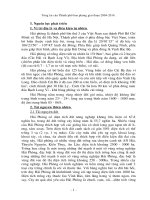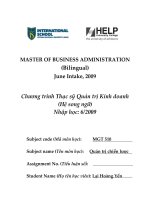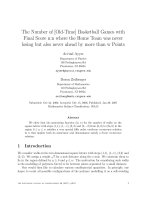FLAVA 2014 final rewards incentives games
Bạn đang xem bản rút gọn của tài liệu. Xem và tải ngay bản đầy đủ của tài liệu tại đây (12.47 MB, 59 trang )
Incentives, Rewards and
Games in the Foreign
Language Classroom.
Linda Lynch
Poquoson High School
Spanish Teacher
Incentives
Punch Cards
3 x 5 index cards in
different colors
ink pad
stamps
different shaped holepunches (available at
Michael’s and A C Moore
for about $1 each).
Punch Cards: Participation Grade
To make:
Stamp each note card. I have different stamps and colored
cards for different weeks (rabbits, pumpkins, etc.)
Make note in the grade/attendance list of the item, for
example: 2 Sept. Green/rabbit. That way if one gets lost, it
can be documented which week was missed.
Punch Cards
Punch Cards: Participation grade
To use:
Pass one out to each student.
Tell them to write their names in ink.
Students, then, will receive a punch for speaking to teacher
in Spanish. Asking to leave the room for any reason, will
not receive a punch. The punches I use are different shapes
so that they are difficult to reproduce.
Punch Card
The student must be using Spanish to communicate or answer a
question to receive a punch.
Each student should talk to me at least twice per day.
At the end of a week (two weeks for a block schedule), he or she
should have 10 punches.
If a student is absent, he writes, “absent 2 oct” for example so that
I can grade it appropriately.
10 = 100%, 9 = 90%, etc.
Token Economy
Materials:
colored paper
printer
template OR money from a board game.
Token Economy:
Participation Grade
- scroll
down on the site for “pesos”.
Other options are: monopoly money or making your own.
COPY DOUBLE SIDED EVERY
OTHER ONE UPSIDE DOWN AT 111%
ENLARGED
green-5
blue-10
red-20
pink-50
grey-100
purple-200
yellow-500
orange-1000
salmon-5000
5L green-100 copies = 3000 (600 bills)
10L blue-100 copies = 6000 (600 bills)
20L red-75 copies = 9000 (450 bills)
50L pink-50 copies = 15,000 (300 bills)
100L grey- 25 copies = 15,000 (150 bills)
200L purple- 20 copies = 24,000 (120 bills)
500L yellow- 20 copies = 60,000 (120 bills)
1000L orange- 5 copies = 30,000 (30 bills)
5000L salmon- 2 copies =60,000 (12 bills)
=222,000 (2382 bills)
Token Economy: Price List
Lista de precios
-¿Puedo usar el baño? -- $20 (bathroom pass)
-¿Puedo ir a la taquilla (oficina, etc)? -- $20 (locker pass)
-No tengo mi libro, ¿Puede Ud. ayudarme? -- $30 (lend a book)
-¿Puede Ud. prestarme (lend me) un lápiz o una pluma?--$10 (lend writing instrument)
-El uso de una tarjeta indice (index) con una prueba --$200 (index card on quiz- I offer
once per 9 weeks. Quiz is my choice)
-¿Cómo se dice______ en inglés? -- $10 (one word or phrase only) (I translate-a work
that they should know.)
-¿Cómo se dice ______ en español?--$10 (one word or phrase only) (I translate-- a word
they should know.)
- Para quitar (take away) un aviso--$100 (works once per day)
- Un paso de tarea--$150 (you may purchase and use 2 per semester)
-Tiempo extra para entregar la tarea- $20—(by end of day—90%)--$50 (next day—
75%)--$75 (next class period—50%) (This is used only twice during a nine week
-Una experiencia cultural--$25,000 (Students may pool money for this, and , yes, it does
have to be educational. )
Token Economy: Price List (cont.)
Lista de precios (continued)
-¿Cómo se dice______ en inglés? -- $10 (one word or phrase only) (I translate-a work
that they should know.)
-¿Cómo se dice ______ en español?--$10 (one word or phrase only) (I translate-- a word
they should know.)
- Para quitar (take away) un aviso--$100 (works once per day)
- Un paso de tarea--$150 (you may purchase and use 2 per semester)
-Tiempo extra para entregar la tarea- $20—(by end of day—90%)--$50 (next day—
75%)--$75 (next class period—50%) (This is used only twice during a nine week
-Una experiencia cultural--$25,000 (Students may pool money for this, and , yes, it does
have to be educational. )
Token Economy: Price List (cont.)
Lista de precios (continued)
-Tiempo extra para entregar la tarea- $20—(by end of day—
90%)--$50 (next day—75%)--$75 (next class period—50%)
(This is used only twice during a nine week
-Una experiencia cultural--$25,000 (Students may pool
money for this, and , yes, it does have to be educational. )
Speedy Speaking Test incentive
Materials:
speaking test questions,
timer,
copies of rubric
This works well with shy students.
Speedy Speaking Test incentive
At least 2 days before, have a list of 8-10 possible speaking test questions
written for the warm-up. Students will copy questions and answer them on the
same paper. (This can be done a day or two before if you want to assign for
homework and check papers individually.)
Ask for possible correct answers. Make sure you write the correct verb forms
on the board for them to make their own corrections.
Line up students in 2 lines (move desks out of the way), facing each other.
If there are an odd number of students, teacher stands in the line that does not
move (line A to begin with).
Line A will ask the questions. Line B will answer. Line A has the
questions/answers. Line B does not. Students will ask/answer to the person
directly across from them.
Set the timer to 30-60 seconds.
Speedy Speaking Test incentive
Tell them to begin asking/answering. Once timer goes off, tell students
in line B to move. Person in front goes to the end and everyone else
moves forward one person. Everyone will have a new partner.
Each time students asking will ask with the next number (first time =
quetion 1, second time = question 2, etc.) that way students will get
through entire list.
Teacher will use speaking test rubric and give students grades as they
answer at the head of the line.
After all of the students in line B have answered. The lines will switch
roles. B will ask and A will answer.
Teacher is always in the “ask” line. (If odd number of students)
Speedy Speaking Test incentive
-Can be used this as an exercise to practice for the speaking test. If things are moving well and
students have been participating well, can be used for the actual speaking test.
-At the beginning of the year, can be used it as practice for the actual test and if students score a
90 or better, let them keep the grade. If they score below, have them retake it next class for a
grade.
-When a class does not want to speak, Can be used as an incentive and let both lines look
without giving any grade, except maybe participation.
-My students have actually begged me to “play” this game..
Sample Speaking Test Rubric:
Flow/Preparedness
1 2
3 4 5
Correct Pronunciation 1 2
3 4 5
Correct Grammar 1
4 5
2 3
Use of current vocabulary 1
2 3 4
Understandability (not due to volume)
Total = 25 points Total _____________
5
1 2
3 4 5
Scratch-off Tickets
Materials:
cardstock
template
craft paint
dish soap
clear contact paper OR clear packing tape
craft paint brush
measuring device
optional: painter’s tape
Materials:
To make:
Scratch-off Tickets
print on cardstock, you can use paper, however, it is a less sturdy and harder to
work with.
Print out your template.
Then, cover the “prize” section with contact paper or packing tape.
Mix 2 parts paint to 1 part dish soap. (EX: 2 T paint: 1 T dish soap)
Put on painter’s tape to border the “prize” section, both top and bottom and sides
if you like (see photos).
Paint inside the painter’s tape borders. This will either take several coats and a lot
of patience, or you can almost pour the paint onto the cards and use the paint
brush to even the paint out.
After at least 5 hours, take off painter’s tape.
Cut into individual cards. A paper cutter is recommended. You can cut the cards,
then, paint if you prefer.
Scratch off template:
Process









